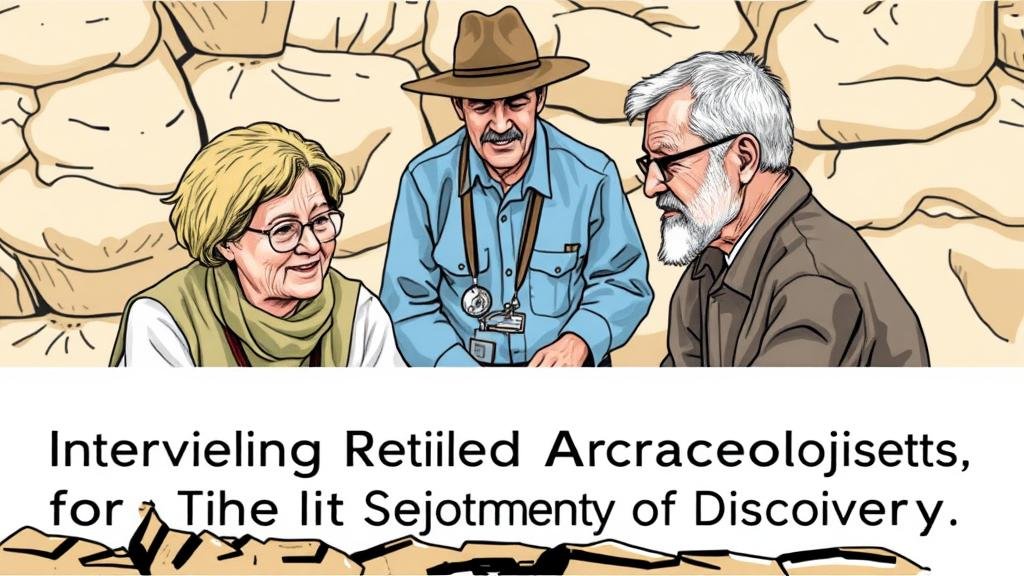Interviewing Retired Archaeologists for Their Personal Stories of Discovery
Interviewing Retired Archaeologists for Their Personal Stories of Discovery
This article explores the significance of interviewing retired archaeologists to gather their personal narratives of discovery and insight. Such narratives serve not only as a valuable record of archaeological practices and insights but also as an engaging medium to convey the human aspects of archaeology. By investigating their experiences, we can uncover diverse perspectives and enhance the public’s understanding of this scientific discipline.
The Importance of Personal Narratives in Archaeology
Personal narratives in archaeology provide crucial insights into the methodologies, challenges, and triumphs faced by archaeologists throughout their careers. e accounts contribute to the historical record of archaeology as a field and showcase the human element underlying scientific exploration.
Several studies highlight the importance of personal narratives. For example, the work of Holtorf (2014) demonstrates how personal stories enrich academic communication and connect audiences to historical events through relatable experiences. Retired archaeologists possess a wealth of knowledge accumulated during their careers, making their testimonies indispensable for understanding the evolution of archaeological thought.
Methodology: Conducting Interviews
Interviews are a common qualitative research method employed in this study. Engaging retired archaeologists through semi-structured interviews allows researchers to explore specific areas of interest while also giving interviewees the freedom to share their stories fluidly. This methodology encourages open dialogue, leading to rich, detailed accounts.
For the purposes of this research, the following steps were undertaken:
- Identify and contact retired archaeologists through academic networks and organizational affiliations.
- Design a semi-structured interview guide with open-ended questions aimed at eliciting personal experiences and anecdotes.
- Conduct interviews either in person or via virtual platforms to ensure accessibility.
- Transcribe and analyze the collected narratives for thematic patterns and significant discoveries.
Case Studies: Notable Interviews
To illustrate the impact of personal stories, several case studies from interviews with retired archaeologists are highlighted below:
Case Study 1: Dr. Emily Richards
Dr. Emily Richards spent her career excavating in the Mediterranean region, specifically in Cyprus. In her interview, Dr. Richards discussed the discovery of a Bronze Age tomb at Enkomi in 1979, which revealed an extensive collection of Cypriot pottery. This excavation not only advanced our understanding of trade networks but also underscored the role of local artisans in a globalized economy of the past. Dr. Richards reflections on working with local communities highlighted an essential aspect often overlooked in archaeological practice–collaboration and mutual respect.
Case Study 2: Dr. Samuel Thompson
Dr. Samuel Thompson, an expert in North American anthropology, recounted his work in the Four Corners region of the United States. In 1986, he led a project that uncovered a previously unknown Ancestral Puebloan site. His insights into the social structures and cultural practices of the Ancestral Puebloans provided invaluable context for interpreting the artifacts found. Dr. Thompson emphasized the importance of storytelling in both indigenous cultures and archaeology, arguing that narratives are key to understanding the past.
Challenges Encountered
While interviewing retired archaeologists can yield rich narratives, several challenges should be acknowledged:
- Memory Bias: Retired individuals may exhibit memory distortions, consciously or unconsciously altering details of their experiences.
- Access and Engagement: Some archaeologists may be reluctant to share personal stories if they believe their work has not received due recognition.
- Representation: Ensuring a diverse group of interviewees that represent various geographic and cultural contexts in archaeology is crucial for a comprehensive understanding.
Conclusion: Implications for Future Research
The integration of personal narratives from retired archaeologists into the broader discourse on archaeology enriches our understanding of the discipline. e accounts serve not only as educational resources but also as a means to humanize the field, bridging the gap between scientific inquiry and public interest.
Future research should focus on creating accessible databases of such narratives to facilitate further studies and outreach programs in archaeology. The ongoing engagement between academia and the public can foster a deeper appreciation for both the scientific rigor and the cultural significance of archaeological endeavors.
In summary, interviewing retired archaeologists is a vital methodological approach for capturing personal stories of discovery. As we continue to explore these narratives, we recognize the unity of science and storytelling in connecting ourselves to the past.



